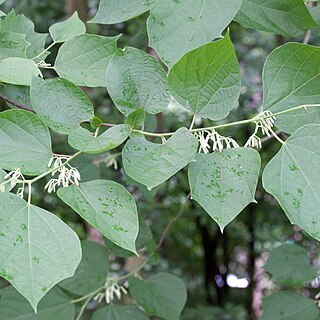Shrubs or small trees, 3-5 m tall. Branchlets pubescent when young, glabrescent. Petiole reddish, 4-6 cm; leaf blade ovate or orbicular to cordate, 8-20 × 5-12 cm, abaxially tufted pubescent at axils of veins, adaxially glabrous, strongly 3-5-veined at base, base usually oblique, occasionally rounded or subrounded, or triangular, margin entire or with few shallow lobes, apex acuminate. Inflorescences axillary cymes, 3-15-flowered. Flowers ca. 2 cm. Calyx lobes 4-7, shortly dentate. Petals valvate, 6(-8), lanceolate, 1-1.5 cm. Stamens 6-8, ca. as many as petals, glabrous. Drupe ovoid, 5-7 mm, seed 1. Fl. May-Jul, Sep-Oct, fr. Jul-Nov.
Leaves (4)10–15(19) × (2·5)4–8(10) cm., varying from narrowly elliptic to broadly ovate, apex acute to mucronate, base rounded or subcuneate to subcordate, often markedly oblique; margins entire to slightly undulate (palmately lobed leaves have been recorded from juvenile plants and from coppiced shoots); petiole 0·5–2·5 cm. long, glabrous or pubescent.
A shrub or small tree. It grows 3-5 m tall. The young branches are hairy. The leaves are oval and 8-20 cm long by 5-12 cm wide. Underneath their are hairs where the veins join. There are 3-15 flowers in a group. The flowers are 2 cm across. The fruit is oval and 5-7 mm across. There is one seed.
Fruit 8–10 × (4)6–8(9) mm., globose or ellipsoidal, somewhat compressed and occasionally slightly eccentric, distinctly ribbed when dry, puberulous, 1–2-loculate, crowned with the disk and the remains of the sepals.
Flowers with a dense golden pubescence on the exterior, white to yellow, reportedly sweet-scented; 5–8-merous, borne 3–10(23) in sparsely branched axillary cymes less than 1/2 the length of the subtending leaves.
Venation typically of 5 main veins ascending from the base of the leaf, some with major laterals and all connected by numerous tertiary veins running approximately parallel and at right angles to the primaries.
Petals strap-shaped, up to 13·5 × 1(1·5) mm., exterior pubescent, interior ± glabrous apart from an area c. 1/2 of the way up from the base.
Stamens the same number as the petals, 5–9 mm. long, pubescent at the base, anthers narrowly linear.
Calyx-tube, 1·5 mm. long ± funnel-shaped, with a narrow spreading limb with 5 minute teeth.
A deciduous tree, to 70 ft. high, fast growing and soft-wooded
Style pubescent, 7–10 mm. long, with a slightly-lobed stigma.
Twigs pubescent when immature and then glabrescent.
Flowers creamy white to pale yellow, fragrant
Pedicels 3–3·5 mm. long.
A tree of 9–24 m. high.
Buds flask-shaped.

